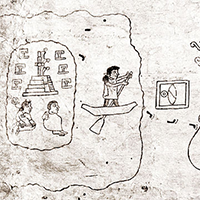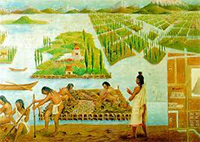The Aztecs: Mesoamerican Empire
Part 1: Foundation and Empire The Aztecs were an economic and cultural powerhouse, ruling much of what is now Mexico and the surrounding area for a few centuries in the late Middle Ages. They came to power by defeating internal rivals, and they lost power by underestimating an overseas foe. 
The Aztecs arrived in what became their most well-known homeland, what many today call Mesoamerica, in the early 13th Century, taking over from the Toltecs (and, some sources say, having a hand in their downfall). Some sources say that the homeland of the Aztecs was Aztlan, to the north, and that the people took their name from their homeland, from which they migrated after a great drought. Some sources name them the Mexica and say that they referred to themselves in that way. Other sources name the Aztecs the Tenochca, the origin for the eventual Aztec capital, Tenochtitlan. 
That city, the result of a combination of swamp-draining and construction of causeways and artificial islands, came about in 1325. Some sources say that the Aztec were compelled to build their city there as the result of a legend. From their capital, the Aztecs ruled far and wide, dominating Mesoamerica for nearly two centuries. 
The Aztecs brought with them their language, Nahuatl. It eventually became the dominant language in Mesoamerica. That language was not a fully developed writing system; rather, it was a symbolic system, a combination of logograms (signs or characters that represent a word or a phrase) and syllable signs. 
The Aztecs for the first of their time in Mesoamerica were one of many city-states. The Aztec civilization became a true empire in 1428, when the Aztec people formed the Three-Way Alliance with the Tacubans and Texcocans to defeat the then-dominant Tepanec, sacking their capital, Azcapotzalco, in the process. Of the three powerful allies, the Aztecs reigned supreme; and at its height, the Aztec Empire ruled over more than 500 small states and included 80,000 square miles, from the Gulf Coast to the Pacific Ocean and down to what now is Guatemala. Estimates are that the rule extended over more than 10 million people. At its largest, Tenochtitlan had a population, some sources say, of 200,000; that would have made it one of the largest cities in the world at that time. 
Reinforcing the dominance of Tenochtitlan was the tribute system, whereby conquered or allied states made payment to the central ruler in the form of goods or services. A large part of the Aztec Empire was rural, and food and pottery and other handmade materials flowed inward, to large markets in the larger cities, creating a market exchange that helped to power the Aztec economy. Other forms of tribute included gold, gems, and jewelry. Some city-states sent people as slaves. In general, if a city-state paid its tribute, the emperor left that city-state to its own affairs and governance. Each altepetl, or city-state, had its own ruler, and the ruler of Tenochtitlan was the supreme ruler, chosen by a council of nobles. The Nahuatl word for emperor was Huey Tlatoani. His top advisor was known as the cihuacoatl. Also advising the emperor was the Council of Four, which usually included army generals. Buttressing this empire was the equivalent of a caste system, which kept the ruler and nobles at the top of the economic and cultural food chain and slaves and indentured servants at the bottom. In between were all the rest of the millions who called the Aztec Empire home. Most nobles were exempt from taxes; all commoners were not, having to pay in goods or labor or the old reliable, money. 
A system of laws governed the civilization. A multi-layered court system featured judges who determined guilt of people accused of breaking those laws and also determined punishment for those found guilty. Punishments were severe. Being sold into slavery was common, and death was not an uncommon result for those found guilty of certain crimes. One particular exception to this was a method of forgiveness, whereby a person who committed an offense could confess their guilt to a priest before being charged with the crime and then be freed from prosecution. This was a one-time-only deal. Innovative techniques such as canals, dikes, irrigation, and terracing helped the Aztecs develop an efficient agricultural Among the crops were avocados, beans, corn (known as maize), potatoes, squashes, and tomatoes. Filling meat needs were hunters of local animals, such as armadillos, coyotes, rabbits, snakes, and turkeys. One particularly valued product was cocoa beans, which were used to make chocolate (which comes from the word chocolatl). Next page > Zenith and Downfall > Page 1, 2
|
|
Social Studies for Kids
copyright 2002–2025
David White



 system. One iconic feature was the chinampa, a narrow garden plot surrounded by water. Such plots were dozens of feet wide and hundreds of feet long.
system. One iconic feature was the chinampa, a narrow garden plot surrounded by water. Such plots were dozens of feet wide and hundreds of feet long.
